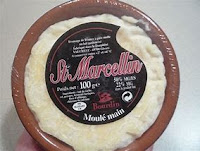 |
Details: Cornish Yarg is a pasteurized cow's milk cheese. Animal rennet is used to form the curds which are then pressed to remove the whey and water. After this process the pressed curds are placed in to round molds to form the cheese. The newly formed cheeses, which weigh about six pounds each, are covered with the fragrant leaves from local Cornish nettle plants. The cheeses are then ready to begin the aging process which creates a natural outer rind. The aging process lasts for a minimum of two months. Some Cornish Yarg cheese is produced without the nettle leave wrapping and it will have a grayish colored natural rind. This version may be a bit less expensive but it would be worth while to purchase the wrapped version if you have a choice.
British Cheese Sampler from Amazon
Flavor: The inner paste of Cornish Yarg is pale yellow and the inner paste is somewhat soft around the inner rind but it should not be oozy or runny. The rind of Cornish Yarg is edible but it is quite bitter so it is best to trim it off before serving. The nettle leaves impart an complex undertone flavor to the cheese that is peppery, grassy, herbaceous and lemony all at once. The cheese itself has a pleasant herbaceous fragrance. You can serve Cornish Yarg as table cheese with fresh fruit or as a stand alone cheese for a snack.
Traditional Cooking of England, Scotland And Wales Cookbook from Amazon
When shopping for Cornish Yarg check to make sure the inner paste is not hard or looks dried out. There should be no apparent signs of mold on the inner paste and no off smelling odors.
Amazon is not carrying this cheese so you will need to search it out in a good local cheese shop, Whole Foods or Wegmans. Cornish Yarg is usually distributed by England's Neal"s Yard Dairy so you may find it easier if you ask your cheese monger what brands of Neal's Yard cheese they carry.
Wine Paring: Dry white wines like California Chardonnay or German Riesling. It also goes well with a pint of English ale.










